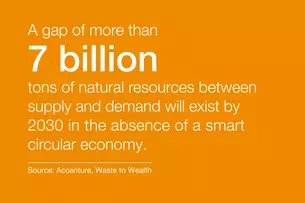Robotics advancing sustainability
Not a trend, but a necessity: sustainable production
They produce photovoltaic modules, fuel cells, and lithium-ion batteries: robots facilitate the breakthrough of ‘green technologies’. Energy-efficient automation solutions contribute to sustainable production even in ‘ordinary’ industrial applications. And it is robot-assisted systems that put the circle in the circular economy of electronic waste recycling.

Towards sustainable production processes
The CO2 reduction goals that the UN and numerous manufacturing companies have set for themselves are ambitious. They cannot be achieved by using ‘green’ energy alone. Entirely new production processes must be developed instead. These redevelopment efforts focus on aspects such as the use of resources, avoiding waste, reducing emissions, and energy efficiency.
automatica will show you how robots can contribute to such efforts. Their energy efficiency as well as their boundless adaptability to performing ever new tasks are two important aspects here. This is why robots do not have to be upgraded or even replaced when their user has a product change coming up. They just need to be reprogrammed and have their grippers or tools adapted to the new application. The robot is then instantly ready to take on new tasks, and for its ‘second life’ in the automated production environment.
Mass production of ‘green products’
Six-axis robots, SCARAs, mobile robots, and autonomous transport vehicle systems already have a strong foothold in and make a valuable contribution to ‘green technologies’, particularly renewable power generation and electromobility. For example, six-axis robots play a pivotal role in the production of huge rotor blades for wind turbines, heavy-duty AGVs transport their nacelles weighing up to 400 tons, and robot-assisted assembly and handling systems ensure that lithium-ion battery production in Germany remains competitive.
Automation even under difficult environmental conditions
At times, new fields of application for automation come with an entirely different set of requirements that is then placed on the equipment suppliers of corresponding systems. An example from battery production: Production standards in this domain include clean room conditions and ambient air with less than one percent relative humidity. In this context, automatica is an opportunity to learn which manufacturers have the capability to supply robots for applications in extremely dry air.
Moreover, you will experience what matters in fuel cell production. For example, each of the 400 to 500 bipolar plates in any given fuel cell stack must be layered with utmost precision and care. This is a job that only high speed robots resistant to corrosion and acid can do.
As industrial products approach the end of their life cycle, it is once again robots that reintegrate the materials, which would previously have been considered scrap, into the circular economy – in automated recycling plants. Plant manufacturers have found solutions for even the trickiest challenges such as developing viable solutions for electric vehicle battery recycling.
Sustainable solutions - sustainable trade fair
All of this is presented and discussed at automatica: Sustainable Production is an important focus topic at this year’s automatica. And, like many of our exhibitors, we would like to make a significant contribution ourselves. This includes:
Climate-friendly stand construction
- No more stand carpeting
- Resource-conserving materials for all special areas
- Carbon neutral and/or environmentally friendlier trade fair stand offers (ECO shell-scheme stand, WOODi system)
Sustainable promotion materials
- Avoidance of print products (including printed catalogs) as much as possible
- Continuous further development of digital advertising
Environmentally friendly infrastructure
- Our GoGreen ticketenables all visitors to make their travel to and from the trade fair carbon-neutral
- Special automatica railway tickets for an environmentally friendly journey
- Great public transport connectivity
- More than 110 charging stations for electric vehicles
Ecological exhibition center
- 2,500 trees to set off carbon emissions
- 35,000 m² of green hall roofs
- One of the world's largest photovoltaic roof-top systems
- 220,000 m² of green spaces
- Geothermal heating
- 100 % green electricity supply
- Trade-fair lake fed by rain and groundwater



